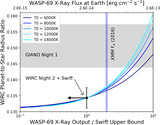Exoplanet Aeronomy: A Case Study of WASP-69 b's Variable Thermosphere
Abstract
Aeronomy, the study of Earth's upper atmosphere and its interaction with the local space environment, has long traced changes in the thermospheres of Earth and other solar system planets to solar variability in the X-ray and extreme-ultraviolet (collectively, XUV) bands. Extending comparative aeronomy to the short-period extrasolar planets may illuminate whether stellar XUV irradiation powers atmospheric outflows that change planetary radii on astronomical timescales. In recent years, near-IR transit spectroscopy of metastable HeI has been a prolific tracer of high-altitude planetary gas. We present a case study of exoplanet aeronomy using metastable HeI transit observations from Palomar Observatory's Wide Field InfraRed Camera and follow-up high-energy data from the Neil Gehrels Swift Observatory that were taken within 1 month of the WASP-69 system, a K-type main-sequence star with a well-studied hot Jupiter companion. Supplemented by archival data, we find that WASP-69's X-ray flux in 2023 was less than 50% of what was recorded in 2016 and that the metastable HeI absorption from WASP-69 b was lower in 2023 versus past epochs from 2017 to 2019. Via atmospheric modeling, we show that this time-variable metastable HeI signal is in the expected direction given the observed change in stellar XUV, possibly stemming from WASP-69's magnetic activity cycle. Our results underscore the ability of multiepoch, multiwavelength observations to paint a cohesive picture of the interaction between an exoplanet's atmosphere and its host star.
- Publication:
-
The Astronomical Journal
- Pub Date:
- August 2024
- DOI:
- 10.3847/1538-3881/ad5354
- arXiv:
- arXiv:2405.19177
- Bibcode:
- 2024AJ....168...65L
- Keywords:
-
- Exoplanet atmospheres;
- Exoplanet evolution;
- Exoplanet astronomy;
- Exoplanet atmospheric dynamics;
- Exoplanet atmospheric variability;
- Planetary atmospheres;
- 487;
- 491;
- 486;
- 2307;
- 2020;
- 1244;
- Astrophysics - Earth and Planetary Astrophysics
- E-Print:
- 25 pages, 15 figures, 6 tables, accepted to The Astronomical Journal
